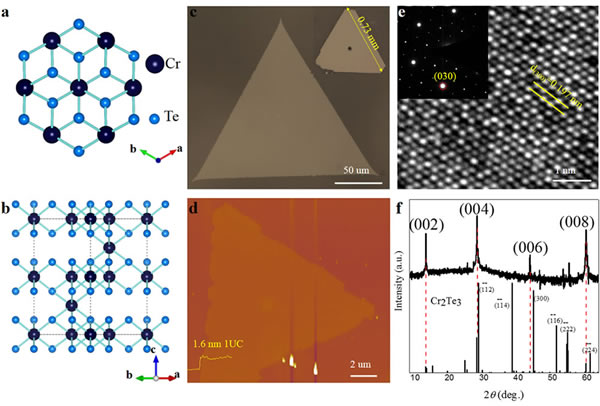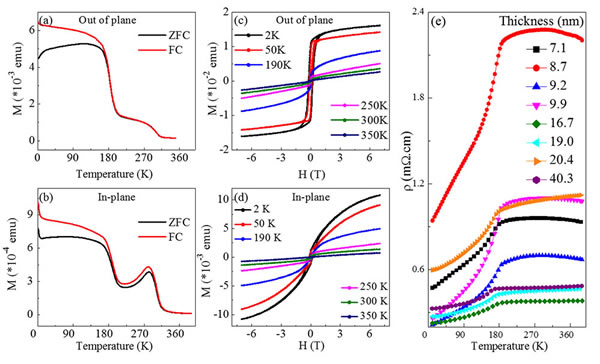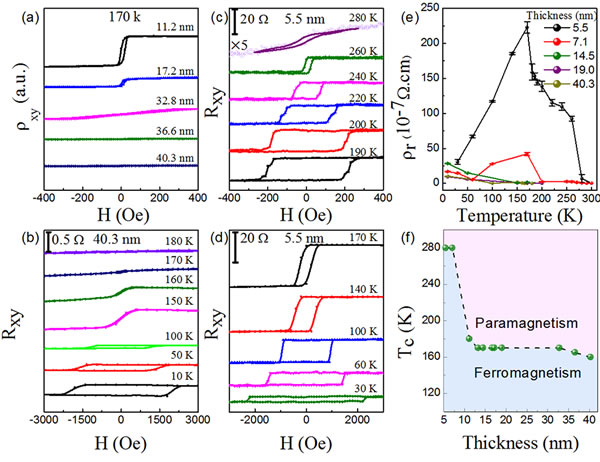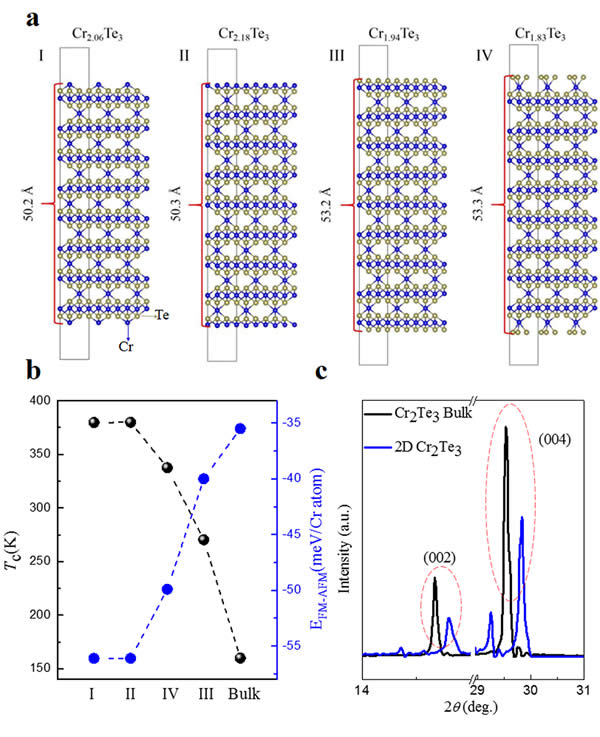When the thickness of the two-dimensional material is reduced to the atomic level, it can lead to the appearance of many novel physical phenomena, making the two-dimensional material a hot research topic in condensed matter physics and materials science. As an important part of the two-dimensional material family, two-dimensional ferromagnets have attracted much attention because of their unique physical properties. Generally, as the thickness of the two-dimensional ferromagnet decreases, its ferromagnetic ordered Curie temperature TC will also decrease, and few materials will increase as the thickness decreases.
Recently, the team of Long Youwen, a researcher from the State Key Laboratory of Magnetism, Institute of Physics, Chinese Academy of Sciences / National Research Center for Condensed Matter Physics, Beijing, and He Jun, a professor from the School of Physical Science and Technology of Wuhan University, worked on Cr2Te3 samples of different thicknesses It was found that its TC gradually increased as the thickness of the material decreased, until the thickness was below the two-dimensional limit (~ 10 nm), the TC sharply increased from 160 K of the bulk to around room temperature (about 280 K), and calculated by theory Revealed the mechanism of this abnormal phenomenon.
All along, according to the Mermin-Wagner theory, long-range ferromagnetic order is difficult to form in two-dimensional materials due to thermal disturbances. However, recently a series of two-dimensional layered materials, such as Cr2Ge2Te6, CrI3, and VSe2, have been found to have long-range ferromagnetism, which has set off a wave of research on the magnetic properties of layered materials (layers connected by van der Waals bonds). However, up to now, there has been no relevant research on the magnetic evolution of non-layered ferromagnetic materials (the atoms are connected by non-van der Waals bonds) until the thickness of one cell is about 1 cell. In order to explore the ferromagnetic behavior of two-dimensional non-layered materials, the research team has grown Cr2Te3 with different thicknesses and characterized their structure, electrical transport, magnetism, and abnormal Hall effect in detail. Studies have shown that when the thickness is greater than 12 nm, the material exhibits ferromagnetic behavior similar to that of the bulk, and its TC increases only slightly as the thickness decreases. However, when the thickness is reduced to 6 cell thicknesses (about 7.1 nm), Tc rises sharply to the room temperature attachment, which can be as high as 280 K, demonstrating the rule contrary to the change in thickness of TC with other ferromagnetic materials. Further through theoretical calculations, the team found that the anomalous change in Cr2Te3 ferromagnetic Curie temperature with thickness may be due to the reconstruction of the surface atoms of the material, making the distance between the surface atoms shorter and enhancing the ferromagnetic interaction. This conclusion further obtained X-ray diffraction Evidence of the results. This work was the first to discover the anomaly of the ferromagnetic Curie temperature rising sharply as the thickness decreases, providing an example for the in-depth study of the novel physical properties of two-dimensional materials, especially non-layered two-dimensional materials.
Related research results were published in the recent Nano. Lett. (20, 3130, 2020). This work was supported by the Ministry of Science and Technology (2018YFE0103200, 2018YFA0305700), the National Natural Science Foundation of China (11934017, 51772324, 11921004, 11574378), the Chinese Academy of Sciences (QYZDB-SSW-SLH013, GJHZ1773), etc.

Figure 1: Cr2Te3 has a triangular crystal structure.

Figure 2: Two-dimensional Cr2Te3 is ferromagnetic, with two magnetic transitions around 280 K and 180 K.

Figure 3: The relationship between the thickness TC and the thickness of Cr2Te3 ferromagnetic Curie with different thickness. When it is lower than the two-dimensional limit (~ 10 nm), TC rises sharply to the room temperature accessory (about 280 K).

Figure 4: Theoretical calculations and XRD tests indicate that two-dimensional Cr2Te3 surface atoms may be reconstructed, making the distance between surface atoms shorter, resulting in a sharp increase in TC.
Dish Rack,dish drying rack,kitchen dish rack,dish drainer rack,dish rack sink,etc. The materials used are 304 stainless steel, easy to clean, never rust!
China Kichen Rack,Sink Grid,Stainless Mesh Storage Baskets,Kitchen Wire Storage, we offered that you can trust. Welcome to do business with us.
Kichen Rack is made of high quality 304 stainless steel, This kind of material steel luxury, never rust, resist corruption, easily clean, safe, healthy and durable. Prevent rust or chemicals from contaminating food and damaging health
kitchen dish rack,dish drainer rack,dish rack sink,Kitchen drying rack,Stainless steel drying rack
Shenzhen Lanejoy Technology Co.,LTD , https://www.szstainlesssteelwiremesh.com
![<?echo $_SERVER['SERVER_NAME'];?>](/template/twentyseventeen/skin/images/header.jpg)